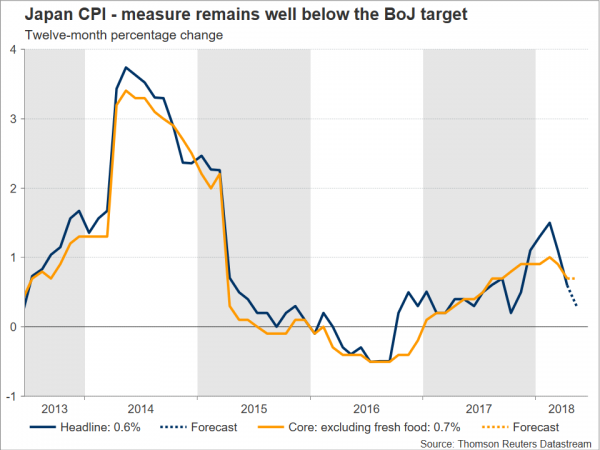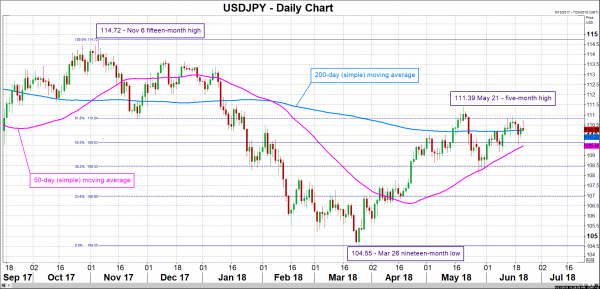Japanese inflation data for May are scheduled for release on Thursday at 2330 GMT. Overall, the numbers are expected to confirm that the Bank of Japan remains far off from its inflation target. Consequently, further monetary policy divergence between the Japanese and US central banks is to be anticipated moving forward, something which favors a stronger dollar/yen pair.
Thursday’s figures out of Japan are projected to show headline inflation as gauged by the consumer price index (CPI) falling to 0.3% y/y in May from April’s 0.6%. Meanwhile, core CPI is forecast to grow at 0.7% y/y for the second straight month; this is the measure that excludes fresh food items but includes energy and which is targeted by the BoJ in its policymaking. This compares to the central bank’s target for inflation of 2% on an annual basis.
Up to (and including) February, price pressures were on the rise in Japan – headline and core CPI grew by 1.5% and 1.0% during the month –, spurring speculation that the country’s central bank was edging closer to entering a path of policy normalization after years of ultra-loose monetary policies. However, the “excitement” was relatively short-lived, with the measures of inflation being in retreat mode ever since. As a consequence, during last week’s meeting on monetary policy, the BoJ downgraded its assessment on inflation, saying it expects consumer price growth to remain in a range of “0.5-1.0%”, from “around 1.0%” which was the view held during April’s meeting; the BoJ seems “locked” into ultra-accommodative policies for the foreseeable future.
Contrast this with the US central bank which remains firmly on policy-tightening mode, having recently delivered its seventh quarter percentage point interest rate increase since it began hiking rates in late 2015, and is projecting a steeper rate path in 2018 than previously thought. All these are pointing to policy divergence between the US and Japan reaching new heights, translating into higher yield differentials (in the US’ favor of course) and being supportive of a stronger USDJPY moving forward.
Turning to FX markets and focusing on dollar/yen, an advancing pair may meet resistance around the 61.8% Fibonacci retracement level of the November 6 to March 26 downleg at 110.84, with the region around this point encapsulating the 111 round figure as well. Stronger bullish movement would turn the attention to the May 21 five-month high of 111.39 and then to the 112 handle. On the downside, immediate support seems to be coming around the current level of the 200-day moving average at 110.23, including the 110 handle. Further below, the area around the 50.0% Fibonacci mark at 109.63, which also includes the 50-day MA at 109.46, would be eyed next.
Lastly, although a CPI beat has the capacity to boost the yen (of course the opposite holds true for a data miss) and bring into scope the abovementioned technical levels, it should be noted that the Japanese currency hasn’t been that sensitive to data releases lately. Instead, safe-haven inflows (or outflows) have been the name of the game for the yen. In this respect, the US-China trade spat has acted as a catalyst driving funds into the safe-haven perceived yen (thus weighing on dollar/yen) over the last number of months – whenever tensions are on the rise that is. Therefore, further escalation of tensions is likely to be met with a depreciating USDJPY, with easing concerns having the opposite effect.














